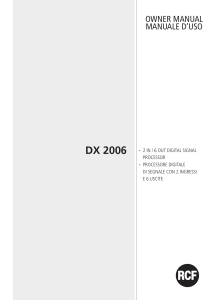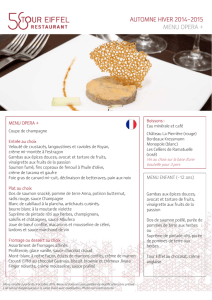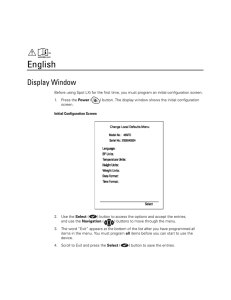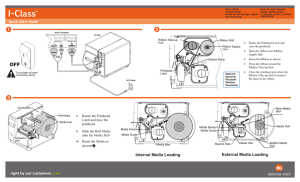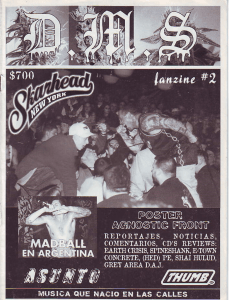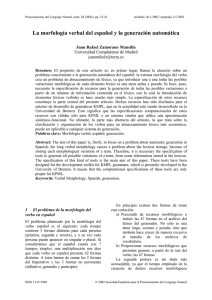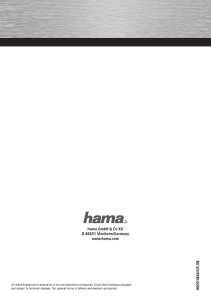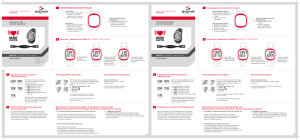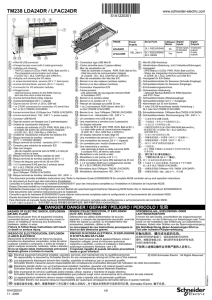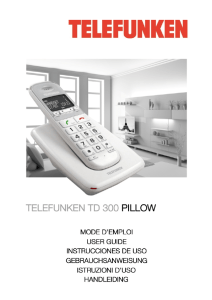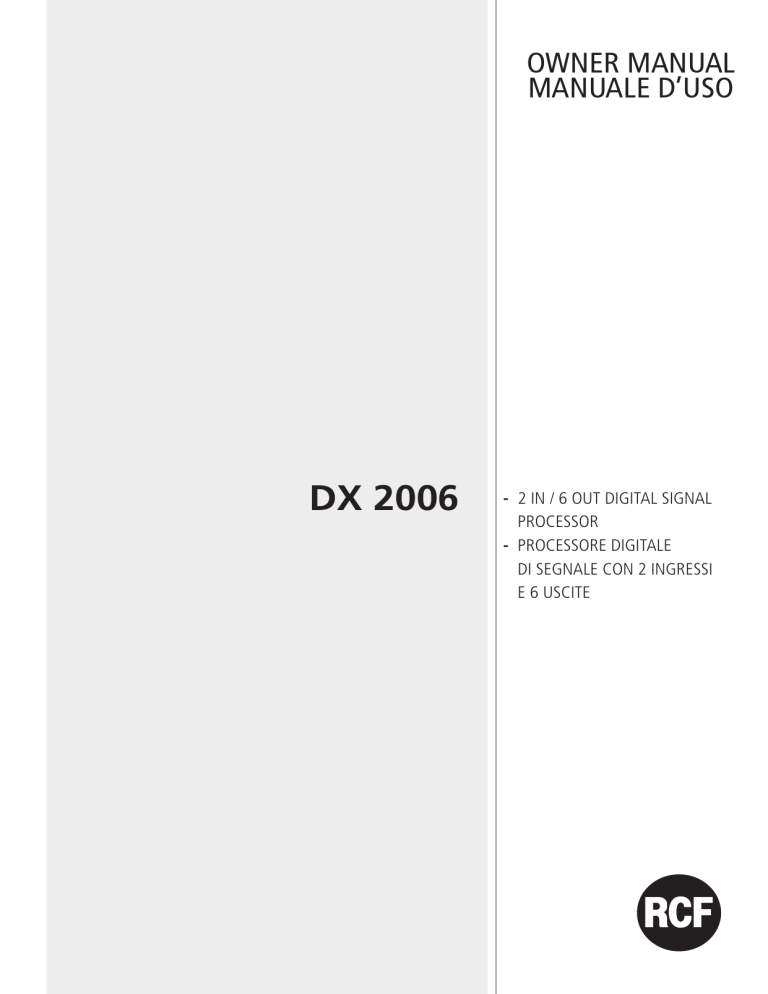
OWNER MANUAL
MANUALE D’USO
DX 2006
- 2 IN / 6 OUT DIGITAL SIGNAL
PROCESSOR
- PROCESSORE DIGITALE DI SEGNALE CON 2 INGRESSI
E 6 USCITE
INDEX
INDICE
ENGLISH
SAFETY PRECAUTIONS
INSTALLATION
DESCRIPTION
FRONT PANEL
REAR PANEL
DISPLAY ‘HOME PAGE’
INPUT / OUTPUT MENUS
SYSTEM MENUS
SPECIFICATIONS
4
6
6
7
8
9
9
14
18
ITALIANO
AVVERTENZE PER LA SICUREZZA INSTALLAZIONE
DESCRIZIONE
PANNELLO FRONTALE
PANNELLO POSTERIORE
SCHERMATA INIZIALE DEL DISPLAY
MENÙ DEGLI INGRESSI E DELLE USCITE
MENÙ DI SISTEMA
DATI TECNICI
20
22
22
23
24
25
25
30
34
ENGLISH
SAFETY
PRECAUTIONS
IMPORTANT
Before connecting and using this product, please read this instruction manual carefully and
keep it on hand for future reference.
The manual is to be considered an integral part of this product and must accompany
it when it changes ownership as a reference for correct installation and use as well as
for the safety precautions. RCF S.p.A. will not assume any responsibility for the incorrect
installation and / or use of this product.
IMPORTANT
WARNING: To prevent the risk of fire or electric shock, never expose this product to rain
or humidity.
WARNING
SAFETY PRECAUTIONS
1. All the precautions, in particular the safety ones, must be read with special
attention, as they provide important information.
2. POWER SUPPLY FROM MAINS
a. The mains voltage is sufficiently high to involve a risk of electrocution; therefore,
never install or connect this product when its power cable is plugged in.
b. Before powering up, make sure that all the connections have been made correctly and
the voltage of your mains corresponds to the voltage shown on the rating
plate on the unit, if not, please contact your RCF dealer.
c. The metallic parts of the unit are earthed by means of the power cable.
d. An apparatus with CLASS I construction shall be connected to a mains socket outlet
with a protective earthing connection.
e. Protect the power cable from damage.
f. Make sure it is positioned in a way that it cannot be stepped on or crushed by
objects.
g. To prevent the risk of electric shock, never open the product: there are no parts
inside that the user needs to access.
3. Make sure that no objects or liquids can get into this product, as this may cause a short
circuit. This apparatus shall not be exposed to dripping or splashing. No objects filled with
liquid, such as vases, shall be placed on this apparatus. No naked sources (such as lighted
candles) should be placed on this apparatus.
4. Never attempt to carry out any operations, modifications or repairs that are not expressly
described in this manual.
Contact your authorized service centre or qualified personnel should any of the following
occur:
- The product does not function (or functions in an anomalous way).
- The power supply cable has been damaged.
- Objects or liquids have got in the unit.
- The product has been subject to a heavy impact.
5. If this product is not used for a long period, disconnect the power cable.
6. If this product begins emitting any strange odours or smoke, switch it off immediately
and disconnect the power supply cable.
7. Do not connect this product to any equipment or accessories not foreseen.
For suspended installation, only use the dedicated anchoring points and do not try to hang
this product by using elements that are unsuitable or not specific for this purpose.
Also check the suitability of the support surface to which the product is anchored (wall,
ceiling, structure, etc.), and the components used for attachment (screw anchors, screws,
brackets not supplied by RCF etc.), which must guarantee the security of the system /
installation over time, also considering, for example, the mechanical vibrations normally
generated by transducers.
ENGLISH
To prevent the risk of falling equipment, do not stack multiple units of this product unless
this possibility is specified in the user manual.
8. RCF S.p.A. strongly recommends this product is only installed by professional
qualified installers (or specialised firms) who can ensure correct installation
and certify it according to the regulations in force.
The entire audio system must comply with the current standards and regulations
regarding electrical systems.
9. Supports and trolleys
The equipment should be only used on trolleys or supports, where necessary, that are
recommended by the manufacturer. The equipment / support / trolley assembly must be
moved with extreme caution. Sudden stops, excessive pushing force and uneven floors may
cause the assembly to overturn.
10. There are numerous mechanical and electrical factors to be considered when installing
a professional audio system (in addition to those which are strictly acoustic, such as sound
pressure, angles of coverage, frequency response, etc.).
11. Hearing loss
Exposure to high sound levels can cause permanent hearing loss. The acoustic pressure
level that leads to hearing loss is different from person to person and depends on the
duration of exposure. To prevent potentially dangerous exposure to high levels of acoustic
pressure, anyone who is exposed to these levels should use adequate protection devices.
When a transducer capable of producing high sound levels is being used, it is therefore
necessary to wear ear plugs or protective earphones.
See the technical specifications in loudspeaker instruction manuals to know their maximum
sound pressure levels.
12. To prevent the occurrence of noise, use screened cables only and avoid putting them
close to:
- Equipment that produces high-intensity electromagnetic fields (for example, high power transformers)
- Mains cables
- Loudspeaker lines.
13. Situate this product far from any heat sources.
14. force the control elements (keys, knobs, etc. ).
15. Do not use solvents, alcohol, benzene or other volatile substances for cleaning the
external parts of this product.
ENGLISH
RCF S.P.A. THANKS YOU FOR PURCHASING THIS PRODUCT, WHICH HAS BEEN
DESIGNED TO GUARANTEE RELIABILITY AND HIGH PERFORMANCES.
INSTALLATION
This device can be installed into a 19” rack cabinet (1 unit) with 4 screws thanks to its
rack ears.
DESCRIPTION
DX 2006 is a digital signal processor designed for loudspeaker management on touring
or fixed sound systems.
Its features include 2 inputs and 6 outputs, 40-bit floating point processors, high
performance 24-bit converters.
The unit has 30 presets to store and recall all settings.
The parameter list includes I/O levels, delay, polarity, 8-band EQ per channel, multiple
crossover selections and limiters.
Precise frequency control is achieved with its 1 Hz resolution.
Inputs can be routed to outputs in multiple configurations.
DX 2006 can be configured in real time either on its front panel or through its intuitive
PC ‘XConsole’ graphic user interface (‘GUI’, via either RS-232 or USB).
Future firmware upgrades (via PC) will keep the device current with newly developed
algorithms and functions.
THE PACKAGE INCLUDES (besides the DX 2006 processor):
- User manual
- PC ‘Xconsole’ software
- Power cable
FEATURES:
- 2 inputs that can be mixed to 6 outputs
- 40-bit floating point DSP
- 96 kHz sampling rate
- 24-bit A/D D/A converters
- 1 Hz frequency resolution (EQ / filters)
- 8 equalizers for each input and output
- Multiple crossover types; limiters
- Level, polarity and delay settings
- Firmware upgrade via PC
- Individual channel buttons (for editing) with linking capability
- 2-Line x 16 character backlit LCD display
- 5-segment LED arrays indicating the signal levels of every input and output
- Storage of up to 30 presets
- Security Lock (with password)
- USB and RS232 ports for PC configuration.
ENGLISH
FRONT PANEL
1
3
2
4
7
5
6
8
9
10
11
1 USB port (type B) for PC link. The driver (from the provided software CD) must be installed.
2 RS232 port (standard DE-9 socket). A ‘straight cable’ is required for PC connection.
3 Input Level LEDs that indicate the current signal level of each input: SIGNAL (signal
presence), –12 dB, –6 dB, –3 dB, OVER/LIMIT (that refers to the device maximum headroom).
4 GAIN/MENU LEDs that indicate the activated inputs for data modification.
5 MUTE Buttons with LEDs – Each button mute or unmute its respective input.
When an input is muted, its LED indicates red.
6 LCD – Display that shows all necessary information to control the unit.
7
Output Level LEDs that indicate the current signal level of each output: SIGNAL (signal
presence), –12 dB, –6 dB, –3 dB, OVER/LIMIT (that refers to the limiter threshold).
8 GAIN/MENU LEDs that indicate the activated outputs for data modification.
9 MUTE Buttons with LEDs – Each button mute or unmute its respective output.
When an output is muted, its LED indicates red.
P Keyboard made of 6 keys:
MENU : while editing, press to select the previous menu.
MENU
: while editing, press to select the next menu.
IMPORTANT:
If a MENU key is pressed and held, MUTE buttons [5, 9] can be used to select which inputs /
outputs are affected by parameter value changes.
IMPORTANT
When inputs / outputs are editable, their GAIN/MENU LEDs [4, 8] indicate green.
It is possible to link either the two inputs or more outputs for common parameter
modification.
It is not possible to edit both inputs and outputs at the same time, therefore first it is
necessary to remove all inputs from the edit mode before adding outputs (or vice-versa).
CURSOR: while editing, press to select the previous parameter.
CURSOR
: while editing, press to select the next parameter.
ENTER: press to access the system menus; while editing, press to confirm.
EXIT: Press to quit and return to the menu ‘home page’.
{
DATA
: rotary thumb wheel that allows to change parameter data values.
This wheel has travel velocity sensing which eases large incremental data modifications.
When adjusting the delay time, pressing and holding the ENTER key permits to increase /
decrease the data value by 1 second steps.
ENGLISH
REAR PANEL
15
1
2
3
4
5
6
1
OUTPUTS
1
AUDIO PROCESSO
R
POW ER
16
14
2
3
DX
2
1
3
GN D
GN D
OUTPUTS
BALANCED SIGNA
L
13
Audio (analogue) balanced outputs (3-pin male XLR connectors).
CABLE MALE XLR CONNECTOR PINS:
SHIELD
– ground
– hot
– cold
w Power connector (standard IEC socket). A compatible power cord is supplied with the unit.
The operating voltage is 90 ÷ 240 V ac (50-60 Hz).
e Fuse type: T2.5A-250V.
r POWER – power switch (I : ON, O = OFF).
INPUTS
12
} INPUTS – Audio (analogue) balanced inputs (3-pin female XLR connectors).
q OUTPUTS –
2
INPUTS
ENGLISH
DISPLAY ‘HOME PAGE’
*** RCF ***
After powering up the unit, the unit boots (it takes a few seconds) and the firmware
release is displayed (for example: 8.03).
***** RCF *****
DX2006
v8.03
As soon as the initialisation ends, the current preset number and name will be displayed.
***** RCF *****
P01*________
The preset number indication is the menu ‘home page’.
The asterisk (when displayed after the preset number) indicates that the current preset
has been edited (parameter value modifications, toggled ‘mute’ buttons, etc.), so the
current settings do not correspond to the ones of the respective stored preset (that needs
to be recalled if it is necessary to restore all previous settings).
DX 2006 is now operating.
INPUT / OUTPUT MENUS
Press and hold a MENU key [P] and press (at the same time) the MUTE buttons [5,
9] of inputs / outputs that need to be edited. GAIN/MENU LEDs [4, 8] of selected
inputs / outputs indicate green.
It is possible to link either the two inputs or more outputs for common parameter
modification.
It is not possible to edit both inputs and outputs at the same time, therefore first it is
necessary to remove all inputs from the edit mode before adding outputs (or vice versa).
Multiple inputs / outputs can be linked or unlinked by pressing sequentially the respective
MUTE buttons [5, 9] (when a MENU key is pressed and held). Any data modification
for the selected input / output is applied to the linked inputs / outputs as well.
IN THE EDIT MODE:
- Press the MENU
key [P] to select the next menu
- Press the
MENU key [P] to select the previous menu
- Press the CURSOR
key [P] to select the next parameter
- Press the
CURSOR key [P] to select the previous parameter
- Turn the DATA rotary thumb wheel [{] to adjust values
- Press the EXIT key [P] to quit.
ENGLISH
THE AVAILABLE MENUS ARE:
- SIGNAL
- EQ (8-band equalizer, from EQ1 to EQ8)
- XOVER (crossover, on outputs only)
- LIMIT (limiter, on outputs only)
- SOURCE (on outputs only)
- NAME
DISPLAY:
C
M
I1:_____ Signal
LEVEL:0.00dB
DISPLAY
P
C : edited channel
•
•
I1 : input 1, I2 : input 2
O1 : output 1, O2 : output 2, O3 : output 3, O4 : output 4
If inputs / outputs are linked, any modification affects all of them (although the display indicates
only one in its top left-hand corner).
M : selected menu
P : selected parameter and its value
SIGNAL MENU
LEVEL
Signal level, range: from – 40 dB to + 15 dB (in 0.25 dB steps).
POL
Signal polarity (phase) that can be normal (+) or inverted (–).
Normal (+) is the suggested default setting.
SIGNAL MENU
I1:_____ Signal
LEVEL:0.00dB
I1:_____ Signal
POL:+
The phase inversion may be useful to compensate or minimise possible undesired acoustical
destructive interferences, due to particular loudspeaker positions.
DELAY
Signal delay, range 0 ÷ 40 ms (in steps of ca. 10 μS; press and hold the ENTER key to
increase / decrease the data value by ca. 1 second steps). It can be displayed in either
milliseconds (ms) or equivalent feet (ft) or metres (m); this setting is explained in the
‘System menus’ manual section.
10
I1:_____ Signal
DELAY:000.000ms
EQ#
Selection of the band to be edited among the 8 available (EQ1 ÷ EQ8).
BYPASS
This parameter toggles the selected band bypass.
If set to ON, the current band setting will not affect the signal.
TYPE
It is possible to choose among 5 different types:
- parametric equalizer (PEQ)
- low-shelf filter (LO-SHF)
- hi-shelf filter (HI-SHF)
- first-order all-pass filter (AP-1)
- second-order all-pass filter (AP-2)
EQ (EQUALIZATION) MENU
ENGLISH
EQ (EQUALIZATION) MENU
I1:______ EQ1
EQ#:1
I1:______ EQ1
BYPASS:Off
I1:______ EQ1
TYPE:PEQ
PEQ
Parametric equalizers (PEQ) allow to adjust the level L at the settable centre frequency
Fc and specify the bandwidth BW (the adjusted level can be widened or narrowed).
Low-shelf filters increase or decrease the level of all frequencies below the centre
frequency by the specified amount.
Hi-shelf filters increase or decrease the level of all frequencies above the centre
frequency by the specified amount.
All-pass filters pass all frequencies equally, but change the signal phase.
FREQ
Equalizer centre frequency setting. Its range is from 20 Hz to 30 kHz in either 1 Hz or
1/36 octave steps (the frequency steps can be chosen in the ‘System menu’, please refer
to the respective manual section).
I1:______ EQ1
FREQ:1000Hz
BW (PEQ, LO-SHF, HI-SHF, AP-2 filters only)
Equalizer bandwidth setting.
Its range is from 0.02 to 3.61 octaves in 0.01 steps.
The equivalent ‘Q factor’ value is automatically displayed besides the octave value.
I1:______ EQ1
BW:0.33 Q=4.36
DEG (AP-1 filter only)
If the first-order all-pass (AP-1) filter is selected, this parameter will set the phase shift
degree at the centre frequency.
The phase shift is gradually changed from 180 degrees to the specified value of the
centre frequency.
I1:______ EQ1
DEG:15.5 deg
LEVEL (PEQ, LO-SHF, HI-SHF filters only)
Equalizer level setting.
Its range is from –30.00 dB to +15.00 dB in 0.25 dB steps.
I1:______ EQ1
LEVEL:0.00dB
11
ENGLISH
XOVER MENU (CROSSOVER, ON OUTPUTS ONLY)
XOVER MENU (CROSSOVER,
ON OUTPUTS ONLY)
Crossovers are needed to split the audio signal into separate frequency bands (in order to get
multi-way sound systems), which can be handled by individual loudspeakers (i.e. woofers, midrange
speakers, tweeters) designed for those bands.
O1:______ XOver
TYPL:Off
TYPL (filter type for the band lower frequency)
It allows to select the high-pass filter type among Butterworth, Linkwitz-Riley or Bessel.
The OFF setting disables the high-pass filter.
FRQL (band lower frequency)
L
FRQL
F
High-pass filter cut-off frequency setting.
Its range is from 20 Hz to 30 kHz in either 1 Hz or 1/36 octave steps (the frequency steps
can be chosen in the ‘System menu’, please refer to the respective manual section).
O1:______ XOver
FRQL:1000Hz
SLPL (filter slope for the band lower frequency)
High-pass filter slope setting.
The available slopes are:
- From 6 dB to 48 dB, 6 dB steps, for the Butterworth and Bessel filter types
- From 12 dB to 48 dB, 12 dB steps, for the Linkwitz-Riley filter type.
O1:______ XOver
SLPL:24dB
TYPH (filter type for the band upper frequency)
It allows to select the low-pass filter type among Butterworth, Linkwitz-Riley or Bessel.
The OFF setting disables the low-pass filter.
O1:______ XOver
TYPH:Off
L
FRQH (band upper frequency)
FRQH
Low-pass filter cut-off frequency setting.
Its range is from 20 Hz to 30 kHz in either 1 Hz or 1/36 octave steps (the frequency steps
can be chosen in the ‘System menu’, please refer to the respective manual section).
O1:______ XOver
FRQH:1000Hz
SLPH (filter slope for the band upper frequency)
Low-pass filter slope setting.
The available slopes are:
- From 6 dB to 48 dB, 6 dB steps, for the Butterworth and Bessel filter types
- From 12 dB to 48 dB, 12 dB steps, for the Linkwitz-Riley filter type.
O1:______ XOver
SLPH:24dB
The insertion of both hi-pass and low-pass filters is a band-pass filter.
L
FRQL
12
F
FRQH F
LIMIT MENU
(LIMITER, ON OUTPUTS ONLY)
ENGLISH
LIMIT MENU (LIMITER, ON OUTPUTS ONLY)
Limiters allow signals below a specified level to pass unaffected and attenuate the peaks of stronger
signals that exceed the threshold.
THRESH
Limiter threshold setting.
Its range is from –20 to +20 dBu (in 0.5 dBu steps).
ATTACK
Limiter attack time setting. Its range is from 0.3 to 1 ms in 0.1 ms steps and from 1 to
100 ms in 1 ms steps.
RELEASE
The limiter release time can be set to 2X, 4X, 8X, 16X or 32X the attack time.
SOURCE MENU (ON OUTPUTS ONLY)
O1:______ Limit
THRESH:+20.0dB
O1:______ Limit
ATTACK:10ms
O1:______ Limit
RELEASE:8XAtck
SOURCE MENU
(ON OUTPUTS ONLY)
IN1
Input 1 level setting for the current output channel.
It can be used to mix the input 1 (by setting the level from –40 to 0 dB) or
disable it (OFF).
O1:______ Source
IN1:Off
IN2
Input 2 level setting for the current output channel.
It can be used to mix the input 2 (by setting the level from –40 to 0 dB) or
disable it (OFF).
O1:______ Source
IN2:-14.00
If both inputs are enabled, they will be mixed together into the current output channel.
NAME MENU
NAME
A 6-character name (a label) can be assigned to each input / output.
Press the CURSOR
key [ P] to select the next character.
Press the
CURSOR key [ P] to return to the previous character.
Turn the DATA rotary thumb wheel [ {] to change characters.
NAME MENU
I1:______ Name
NAME:______
13
ENGLISH
SYSTEM MENUS
The system menus allow the user to control and change parameters that are related to
the unit general operation. These can be accessed by pressing the ENTER key [P] when
the display shows the ‘home page’ (when no input/output menu is activated).
All system menus require to press ENTER key [P] twice to confirm and save new
settings.
AFTER ENTERING:
- Press the MENU
key [P] to select the next menu
- Press the
MENU key [P] to select the previous menu
- Press the CURSOR
key [P] to select the next parameter
- Press the
CURSOR key [P] to select the previous parameter
- Turn the DATA rotary thumb wheel [{] to adjust values
- Press the ENTER key [P] to proceed / confirm
- Press the EXIT key to quit.
THE AVAILABLE MENUS ARE:
- PRESET RECALL (‘Recall’ is displayed)
- PRESET STORE (‘Store’ is displayed)
- INPUT / OUPUT COPY (‘Copy’ is displayed)
- GENERAL SETTINGS (‘Generl’ is displayed)
- COMMUNICATION SETTINGS (‘Comm’ is displayed)
- SECURITY (‘Secure’ is displayed)
- FACTORY SETTINGS (‘Reset’ is displayed)
- INTERNAL SYSTEM OPTIMIZER (noise gate, ‘ISO’ is displayed)
- INFO
PRESET RECALL MENU
P:n
This parameter allows to select which preset (n) will be recalled from the internal
memory.
The program name is displayed beside the program number.
PRESET STORE MENU
PRESET RECALL MENU
SYSTEM Recall
P:1 _________
PRESET STORE MENU
DX 2006 has a built in non-volatile memory that can store up to 30 different presets.
A preset can be stored using this menu. The old preset having with the same number will
be replaced. Once the preset is stored on the internal memory, it can be always recalled,
even after powering down.
P:n
This parameter allows to select which preset (n) will be stored on the internal memory.
NAM:
A descriptive name (a label) of up to 12 characters can be assigned to each preset.
Press the CURSOR
key [P] to select the next character.
Press the
CURSOR key [P] to return to the previous character.
Turn the DATA rotary thumb wheel [{] to change characters.
14
SYSTEM Store
P:1
SYSTEM Store
NAM:_________
THIS MENU ALLOWS TO COPY INPUTS / OUTPUTS:
- When the source and the target are both inputs, all parameter values will be copied
- When the source and the target are both outputs, all parameters values will be copied
- If the source is an input and the target is an output (or vice-versa), ‘Level’, ‘Polarity’,
‘Delay’, ‘EQ’ and ‘Name’ will be copied only.
SOURCE
Source input / output from which data are copied.
TARGET
Target input / output to which data are copied.
GENERAL SETTINGS MENU
FREQ MODE
Setting of the frequency control mode for EQ and crossover filters.
It can be either 36 steps/octave or all frequencies (1 Hz resolution).
DELAY UNIT
Delay unit setting: the delay can be displayed in either milliseconds (ms) or equivalent
feet (ft) or metres (m).
COMMUNICATION SETTINGS MENU
INPUT / OUPUT COPY MENU
ENGLISH
INPUT / OUPUT COPY MENU
SYSTEM Copy
SOURCE:In1
SYSTEM Copy
TARGET:In2
GENERAL SETTINGS MENU
SYSTEM Generl
FREQ MODE:All
SYSTEM Generl
DELAY UNIT:ms
COMMUNICATION SETTINGS MENU
NOTE: the unit needs to be rebooted (switch the unit OFF, then ON again) before new
communication settings take effect.
DEVICE ID
This setting assigns a device ID number (from 1 to 16) to the unit. This ID is only useful
when a network of more than 1 device is used. In normal operation the device ID is 1.
BAUD RATE
Serial communication baud rate setting.
PC ‘XConsole’ uses a baud rate of 115200, so this value should be left unchanged.
SECURITY MENU
PASSWORD
A new DX 2006 does not require a password.
The device can be protected against unauthorized editing by a 4-character password,
which can be stored when using the PC ‘Xconsole’ software only.
When the correct password is entered, the parameter protection will be disabled.
After re-entering the password (or turning the unit off), the parameter protection will be
enabled again.
Press the CURSOR
key [P] to select the next character.
Press the
CURSOR key [P] to return to the previous character.
Turn the DATA rotary thumb wheel [{] to change characters.
SYSTEM Comm
DEVICE ID:1
SYSTEM Comm
BAUD RATE:115200
SECURITY MENU
SYSTEM Secure
PASSWORD:____
15
ENGLISH
FACTORY SETTINGS MENU
RESET CURRENT
If necessary, turn the DATA rotary thumb wheel [11] to select YES, then press ENTER [10]
twice to reset all current parameter values back to factory default settings.
FACTORY SETTINGS MENU
SYSTEM Reset
CURRENT:Yes
Note: stored presets and system settings are not affected by the reset function!
Attention: this function deletes all current value changes!
INTERNAL SYSTEM OPTIMIZER MENU (NOISE GATE)
INTERNAL SYSTEM OPTIMIZER
MENU (NOISE GATE)
The unit features a ‘noise gate’ that reduces the ground floor noise when no signal is
present on inputs.
THRESHOLD
The noise gate threshold level can be adjusted (from 80 to 120).
BYPASS
If unwanted noise gate effects are audible on low sound levels, the noise gate can be
disabled by setting BYPASS to ON.
INFO MENU
NAM (name)
The device name is displayed.
FIRMWARE
The firmware release is displayed.
CODE
This code is 11110000 if no security password has been set (factory setting).
If this code is not 11110000, a security password has been set and parameters cannot
be modified by an user that does not know the right password.
16
SYSTEM ISO
THRESHOLD:102
SYSTEM ISO
BYPASS:On
INFO MENU
SYSTEM Info
NAM:_________
SYSTEM Info
FIRMWARE:v8.00
SYSTEM Info
CODE:11110000
MENU
ENGLISH
CHANNEL PARAMETER REFERENCE
PARAMETER
MIN. VALUE
MAX. VALUE
STEPS
UNIT
Level
– 40
+ 15
0.25
dB
Polarity
Signal
Delay
EQ number
Equalizer
Crossover
(high-pass,
low-pass)
Limiter
+/–
0
40
0.010 / 0.011
mS
0
45.538
0.011 / 0.012
ft
0
13.876
0.003 / 0.004
m
1
8
1
Bypass
Off / On
Type
PEQ / LO-SHF / HI-SHF / AP-1 / AP-2
Frequency
20
30 000
1 Hz / 1/36oct
Hz / octaves
Bandwidth
0.02
3.61
0.01
octaves
Degree (AP-1)
0
179.5
0.5
degrees
Level
– 30
+ 15
0.25
dB
Type
Off / Butterworth / Linkwitz-Riley / Bessel
Cutoff frequency
20
30 000
1 Hz / 1/36oct
Hz / octaves
Slope
6 /(12 LR)
48
6 / (12 LR)
dB
Threshold
– 20
+ 20
0.5
dBu
Attack time
0.3
100
0.1 / 1
ms
Release time
Source
Name
2x / 4x / 8x / 16x / 32x Attack time
Input 1 level
Off / – 40
0
0.25
dB
Input 2 level
Off / – 40
0
0.25
dB
Name
6 characters
PC SOFTWARE
DX 2006 is shipped with a special PC Graphic User Interface (GUI) application, named
‘Xconsole’, which allows the user to control the unit from a PC.
Presets can be recalled and stored from/to PC hard disk.
DX 2006 can be linked to a PC via either RS232 or USB.
USB may require the installation of additional drivers.
17
ENGLISH
SPECIFICATIONS
INPUTS AND OUTPUTS
Input Impedance:
Output Impedance:
Maximum Level:
Type:
>10 kΩ
50 Ω
+20 dBu
Electronically balanced
AUDIO PERFORMANCE
Frequency Response:
Dynamic Range:
CMMR:
Crosstalk:
Distortion:
± 0.1 dB (20 ÷ 30 kHz)
115dB typ (unweighted)
> 60dB (50 to 10kHz)
< – 100 dB
0.002% (1 kHz @ +4 dBu)
DIGITAL AUDIO
Processor:
Sampling Rate:
Converters:
Latency:
FRONT PANEL CONTROLS
Display:
Level Meters:
Buttons:
Dial Encoder:
CONNECTORS
Analogue Inputs:
Analogue Outputs:
RS-232:
USB:
Power:
AUDIO CONTROL PARAMETERS
Gain:
Polarity:
Delay:
Delay Units:
2 x 16 Character Backlit LCD
5 LEDs x channel
Mute/Edit Controls, Menu Controls
Embedded Thumb Wheel
3-pin female XLR
3-pin male XLR
Female D-sub DE-9
Type B
Standard IEC Socket with fuse
– 40 ÷ +15 dB in 0.25 dB steps
+/–
up to 40 ms per input / output
ms, ft, m
EQUALIZERS (8 PER INPUT / OUTPUT)
Type:
Gain:
Bandwidth:
Parametric, Lo-shelf, Hi-shelf, AP-1, AP-2
–15 ÷ +15 dB in 0.25 dB steps
0.02 to 3.61 octaves
CROSSOVER FILTERS (2 PER OUTPUT)
Filter Types:
Slopes:
Butterworth, Linkwitz Riley, Bessel
6 / 12 to 48 dB / oct
LIMITERS (1 PER OUTPUT)
Threshold:
Attack time:
Release time:
GENERAL
Preset Number:
Frequency Modes:
Operating voltage:
Dimensions (w, h, d):
Net weight:
18
40 bits
96 kHz
24 bits
1.5 ms
–20 ÷ +20 dBu
0.3 ÷ 100 ms
2-4-8-16-32x the attack time
30
1 Hz resolution, 36 steps/oct
90 ÷ 240 V ac (50-60 Hz)
483 x 44 x 229 mm (19”x 1.75”x 9”), 1 rack unit (19”)
4.5 kg (10 lbs)
ITALIANO
AVVERTENZE PER
LA SICUREZZA
IMPORTANTE
Prima di collegare ed utilizzare questo prodotto, leggere attentamente le istruzioni
contenute in questo manuale, il quale è da conservare per riferimenti futuri. Il presente
manuale costituisce parte integrante del prodotto e deve accompagnare quest’ultimo
anche nei passaggi di proprietà, per permettere al nuovo proprietario di conoscere le
modalità d’installazione e d’utilizzo e le avvertenze per la sicurezza.
L’installazione e l’utilizzo errati del prodotto esimono la RCF S.p.A. da ogni responsabilità.
IMPORTANTE
ATTENZIONE: Per prevenire i rischi di fiamme o scosse elettriche, non esporre mai questo
prodotto alla pioggia o all’umidità.
ATTENZIONE
AVVERTENZE PER LA SICUREZZA
1. Tutte le avvertenze, in particolare quelle relative alla sicurezza, devono essere lette con
particolare attenzione, in quanto contengono importanti informazioni.
2. ALIMENTAZIONE DIRETTA DA RETE
a. La tensione di alimentazione dell’apparecchio ha un valore sufficientemente alto da
costituire un rischio di folgorazione per le persone: non procedere mai all’installazione
o connessione dell’apparecchio con il cavo d’alimentazione collegato alla rete.
b. Prima di alimentare questo prodotto, assicurarsi che tutte le connessioni siano
corrette e che la tensione della vostra rete di alimentazione corrisponda quella di
targa dell’apparecchio, in caso contrario rivolgetevi ad un rivenditore RCF.
c. Le parti metalliche dell’apparecchio sono collegate a terra tramite il cavo di
alimentazione. Un apparecchio avente costruzione di CLASSE I deve essere connesso
alla presa di rete con un collegamento alla terra di protezione.
d. Accertarsi che il cavo di alimentazione dell’apparecchio non possa essere calpestato o
schiacciato da oggetti, al fine di salvaguardarne la perfetta integrità.
e. Per evitare il rischio di shock elettrici, non aprire mai l’apparecchio: all’interno non vi
sono parti che possono essere utilizzate dall’utente.
3. Impedire che oggetti o liquidi entrino all’interno del prodotto, perché potrebbero causare
un corto circuito. L’apparecchio non deve essere esposto a stillicidio o a spruzzi d’acqua;
nessun oggetto pieno di liquido, quali vasi, deve essere posto sull’apparecchio.
Nessuna sorgente di fiamma nuda (es. candele accese) deve essere posta sull’apparecchio.
4. Non eseguire sul prodotto interventi / modifiche / riparazioni se non quelle espressamente
descritte sul manuale istruzioni.
Contattare centri di assistenza autorizzati o personale altamente qualificato quando:
- l’apparecchio non funziona (o funziona in modo anomalo);
- il cavo di alimentazione ha subito gravi danni;
- oggetti o liquidi sono entrati nell’apparecchio;
- l’apparecchio ha subito forti urti.
5. Qualora questo prodotto non sia utilizzato per lunghi periodi, scollegare il cavo
d’alimentazione.
6. Nel caso che dal prodotto provengano odori anomali o fumo, spegnerlo
immediatamente e scollegare il cavo d’alimentazione.
7. Non collegare a questo prodotto altri apparecchi e accessori non previsti.
Quando è prevista l’installazione sospesa, utilizzare solamente gli appositi punti di
ancoraggio e non cercare di appendere questo prodotto tramite elementi non idonei o
previsti allo scopo.
Verificare inoltre l’idoneità del supporto (parete, soffitto, struttura ecc., al quale è ancorato
il prodotto) e dei componenti utilizzati per il fissaggio (tasselli, viti, staffe non fornite
da RCF ecc.) che devono garantire la sicurezza dell’impianto / installazione nel tempo,
anche considerando, ad esempio, vibrazioni meccaniche normalmente generate da un
trasduttore.
Per evitare il pericolo di cadute, non sovrapporre fra loro più unità di questo prodotto,
quando questa possibilità non è espressamente contemplata dal manuale istruzioni.
20
ITALIANO
8. La RCF S.p.A. raccomanda vivamente che l’installazione di questo prodotto
sia eseguita solamente da installatori professionali qualificati (oppure da ditte
specializzate) in grado di farla correttamente e certificarla in accordo con le
normative vigenti.
Tutto il sistema audio dovrà essere in conformità con le norme e le leggi vigenti
in materia di impianti elettrici.
9. Sostegni e Carrelli
Se previsto, il prodotto va utilizzato solo su carrelli o sostegni consigliati dal produttore.
L’insieme apparecchio-sostegno / carrello va mosso con estrema cura. Arresti improvvisi,
spinte eccessive e superfici irregolari o inclinate possono provocare il ribaltamento
dell’assieme.
10. Vi sono numerosi fattori meccanici ed elettrici da considerare quando si installa un
sistema audio professionale (oltre a quelli prettamente acustici, come la pressione sonora,
gli angoli di copertura, la risposta in frequenza, ecc.).
11. Perdita dell’udito
L’esposizione ad elevati livelli sonori può provocare la perdita permanente dell’udito. Il
livello di pressione acustica pericolosa per l’udito varia sensibilmente da persona a persona
e dipende dalla durata dell’esposizione. Per evitare un’esposizione potenzialmente
pericolosa ad elevati livelli di pressione acustica, è necessario che chiunque sia sottoposto
a tali livelli utilizzi delle adeguate protezioni; quando si fa funzionare un trasduttore in
grado di produrre elevati livelli sonori è necessario indossare dei tappi per orecchie o delle
cuffie protettive.
Consultare i dati tecnici contenuti nei manuali istruzioni per conoscere le massime pressioni
sonore che i diffusori acustici sono in grado di produrre.
12. Per evitare fenomeni di rumorosità indotta sui cavi che trasportano segnali audio, usare
solo cavi schermati ed evitare di posarli nelle vicinanze di:
- apparecchiature che producono campi elettromagnetici di forte intensità (per esempio
trasformatori di grande di potenza);
- cavi di rete;
- linee che alimentano altoparlanti.
13. Collocare il prodotto lontano da fonti di calore.
14. Non forzare mai gli organi di comando (tasti, manopole ecc.).
15. Non usare solventi, alcool, benzina o altre sostanze volatili per la pulitura delle parti
esterne dell’unità.
21
ITALIANO
RCF S.P.A. VI RINGRAZIA PER L’ACQUISTO DI QUESTO PRODOTTO, REALIZZATO
IN MODO DA GARANTIRNE L’AFFIDABILITÀ E PRESTAZIONI ELEVATE.
INSTALLAZIONE
L’apparecchio può essere installato in un rack 19” (1 unità) tramite 4 viti, grazie alle sue
alette laterali.
DESCRIZIONE
DX 2006 è un processore digitale di segnale per la gestione dei diffusori nei sistemi ad
installazione fissa o per tour.
Include 2 ingressi e 6 uscite, un processore 40-bit a virgola mobile, convertitori 24 bit ad
alte prestazioni.
L’unità ha 30 programmi / memorie (“preset”) per memorizzare e richiamare tutte le
impostazioni.
Tra i parametri, sono presenti i livelli degli ingressi e delle uscite, il ritardo (“delay”),
la polarità, un equalizzatore ad 8 bande EQ per canale, selezioni multiple di crossover,
limitatori.
È possibile un controllo preciso della frequenza d’intervento grazie alla risoluzione di 1 Hz.
I 2 ingressi possono essere inviati alle 6 uscite in diverse configurazioni.
Il processore DX 2006 può essere configurato in tempo reale tramite il suo pannello
frontale o attraverso l’intuitiva interfaccia grafica del software per PC “Xconsole” (via RS232 od USB).
Aggiornamenti futuri del firmware (tramite PC) manterranno l’apparecchio attuale con gli
ultimi algoritmi e funzioni disponibili.
NELL’IMBALLO SONO INCLUSI (oltre al processore DX 2006):
- il manuale d’uso;
- il software per PC ‘Xconsole’;
- il cavo d’alimentazione.
CARATTERISTICHE PRINCIPALI:
- 2 ingressi miscelabili verso 6 uscite;
- DSP 40-bit a virgola mobile;
- frequenza di campionamento 96 kHz;
- convertitori A/D D/A a 24-bit;
- risoluzione della frequenza 1 Hz (equalizzatori, filtri);
- 8 equalizzatori per ogni ingresso ed uscita;
- diversi tipi di crossover; limitatori;
- impostazioni dei livelli, polarità e ritardo;
- aggiornamento del firmware tramite PC;
- tasti individuali (con possibilità di raggrupparli) per la selezione di ciascun canale da
modificare;
- display retroilluminato 2 linee x 16 caratteri;
- linee di 5 LED per le indicazione dei segnali di ciascun ingresso ed uscita;
- memorizzazione di (max.) 30 “presets” (configurazioni);
- blocco di sicurezza tramite password;
- porte USB e RS232 per la configurazione da PC.
22
ITALIANO
PANNELLO FRONTALE
1
3
2
4
7
5
6
8
9
10
11
1 Porta USB (tipo B) per collegamento a PC. Il “driver” (sul CD a corredo) deve essere installato.
2 Porta RS232 (presa standard DE-9). E’ necessario un cavo “pin to pin” per il collegamento al PC.
3 Indicatori (LED) del livello corrente del segnale di ciascun ingresso: SIGNAL (presenza del segnale), –12 dB, –6 dB, –3 dB, OVER/LIMIT (livello massimo, picco).
4 Indicatori (LED) GAIN/MENU degli ingressi selezionati per la modifica dei parametri.
5 Tasti MUTE con LED – Ogni tasto disattiva (“mute”) od attiva il rispettivo ingresso.
Quando un ingresso è disattivato, si accende il LED rosso del relativo tasto.
6 Display dove sono mostrate le informazioni necessarie per l’uso dell’apparecchio.
7 Indicatori (LED) del livello corrente del segnale di ciascuna uscita: SIGNAL (presenza del segnale),
–12 dB, –6 dB, –3 dB, OVER/LIMIT (livello massimo, picco).
8 Indicatori (LED) GAIN/MENU delle uscite selezionate per la modifica dei parametri.
9 Tasti MUTE con LED – Ogni tasto disattiva (“mute”) od attiva la rispettiva uscita.
Quando un’uscita è disattivata, si accende il LED rosso del relativo tasto.
P Tastiera avente 6 tasti:
MENU : durante le modifiche, premere per selezionare il menu precedente.
MENU
: durante le modifiche, premere per selezionare il menu successivo.
IMPORTANTE:
Se si mantiene premuto un tasto MENU, i tasti MUTE [5, 9] possono essere usati per selezionare
quali ingressi / uscite sono soggetti alla modifica dei parametri.
IMPORTANTE
Quando gli ingressi / le uscite sono modificabili, i loro LED verdi GAIN/MENU [4, 8]
sono accesi. È possibile collegare sia i due ingressi si più uscite tra loro per una modifica
comune dei parametri. Non è possibile modificare insieme ingressi ed uscite allo stesso
tempo, pertanto è necessario togliere gli ingressi dalla modalità di modifica prima di
selezionare le uscite (o viceversa).
CURSOR: durante le modifiche, premere per selezionare il parametro precedente.
CURSOR
: durante le modifiche, premere per selezionare il parametro successivo.
ENTER: premere per accedere ai menù di sistema; durante le modifiche, premere per confermare.
EXIT: premere per uscire e ritornare alla schermata iniziale del display.
{
DATA
: controllo rotante che permette di cambiare il valore dei parametri.
Questo controllo è sensibile alla velocità di rotazione: aumentandola, si ha un maggiore
incremento differenziale. Quando si modifica il tempo di ritardo (“delay”), tenere premuto il
tasto ENTER consente di aumentare o diminuire il valore con passi da un secondo.
23
ITALIANO
PANNELLO POSTERIORE
15
1
2
3
4
5
6
1
OUTPUTS
1
AUDIO PROCESSO
R
POW ER
16
14
2
3
DX
2
1
3
GN D
GN D
OUTPUTS
BALANCED SIGNA
L
13
q OUTPUTS – Uscite audio bilanciate (analogiche) con connettori XLR tripolari maschi.
CONTATTI DI UN CONNETTORE XLR MASCHIO (DEL CAVO):
– massa
– segnale
– segnale
w Connettore (IEC standard) per il cavo d’alimentazione fornito a corredo.
La tensione di funzionamento è 90 ÷ 240 V ac (50-60 Hz).
e Tipo di fusibile: T2.5A-250V.
r Interruttore principale (I : acceso, O = spento).
24
INPUTS
12
} INPUTS – Ingressi audio bilanciati (analogici) con connettori XLR tripolari femmine.
CALZA
2
INPUTS
ITALIANO
SCHERMATA INIZIALE DEL DISPLAY
*** RCF ***
Dopo aver acceso l’apparecchio, si ha la fase d’inizializzazione (qualche secondo) ed è
mostrata la versione del firmware (nell’esempio sotto: 8.03).
***** RCF *****
DX2006
v8.03
Non appena l’inizializzazione è terminata, è mostrato il programma corrente ed il
suo nome.
***** RCF *****
P01*________
L’indicazione del numero di programma è la schermata iniziale del display.
L’asterisco (quando appare dopo il numero del programma) indica che il programma
attuale è stato modificato (modifiche ai valori dei parametri, commutazione dei tasti
MUTE, ecc.), pertanto le impostazioni correnti NON corrispondono a quelle del rispettivo
programma memorizzato (che deve essere richiamato nel caso sia necessario ripristinare
le impostazioni precedenti alle modifiche).
Il processore DX 2006 è ora funzionante.
MENÙ DEGLI INGRESSI E DELLE USCITE
Premere e tener premuto un tasto MENU [P] e contemporaneamente premere i tasti
MUTE [5, 9] degli ingressi / uscite da modificare; i LED verdi GAIN/MENU [4, 8]
degli ingressi / delle uscite selezionate si accendono.
È possibile unire i due ingressi oppure più uscite tra loro per una modifica comune dei
parametri.
Non è possibile modificare insieme ingressi ed uscite, pertanto è necessario rimuovere gli
ingressi dalla modalità di modifica prima di aggiungere le uscite (o viceversa).
Più ingressi / uscite possono essere uniti (o rimossi) premendo sequenzialmente i rispettivi
tasti MUTE [5, 9] (quando si tiene premuto un tasto MENU). Qualsiasi modifica al
canale selezionato è applicata ai due ingressi uniti od alle uscite collegate tra loro.
NELLA MODALITÀ DI MODIFICA:
- premere il tasto MENU
[P] per selezionare il menù successivo;
- premere il tasto
MENU [P] per selezionare il menù precedente;
- premere il tasto CURSOR
[P] per selezionare il parametro successivo;
- premere il tasto
CURSOR [P] per selezionare il parametro precedente;
- ruotare il controllo DATA [{] per cambiare i valori;
- premere il tasto EXIT [P] per uscire.
25
ITALIANO
I MENÙ DISPONIBILI SONO:
- SIGNAL (segnale audio)
- EQ (equalizzatore a 8 bande, da EQ1 a EQ8)
- XOVER (crossover; disponibile solo per le uscite)
- LIMIT (limitatore; disponibile solo per le uscite)
- SOURCE (miscelazione degli ingressi; disponibile solo per le uscite)
- NAME (nome)
INDICAZIONI SUL DISPLAY:
C
M
I1:_____ Signal
LEVEL:0.00dB
INDICAZIONI SUL DISPLAY
P
C : canale selezionato per le modifiche
•
•
I1 : ingresso 1, I2 : ingresso 2
O1 : uscita 1, O2 : uscita 2, O3 : uscita 3, O4 : uscita 4
Se i 2 ingressi o più uscite sono collegati tra loro, qualsiasi modifica è comune a tutti i canali
selezionati (nonostante il display indichi solo un canale nel suo angolo in alto a sinistra).
M : menù selezionato
P : parametro selezionato ed il suo valore
MENÙ SIGNAL (SEGNALE)
LEVEL(livello)
Livello del segnale (da – 40 dB a + 15 dB con passi da 0,25 dB).
POL (polarità)
Polarità (fase) del segnale, che può essere normale (+) od invertita (–). La polarità
normale (+) è quella consigliata e preimpostata.
MENÙ SIGNAL (SEGNALE)
I1:_____ Signal
LEVEL:0.00dB
I1:_____ Signal
POL:+
L’inversione di fase potrebbe essere utile per compensare or minimizzare possibili (ed indesiderate)
interferenze acustiche distruttive dovute, per esempio, a particolari posizioni dei diffusori acustici.
DELAY (ritardo)
Ritardo del segnale (tempo: 0 ÷ 40 ms, con passi da c. 10 μS). Premere e tenere premuto
il tasto ENTER per aumentare / diminuire il tempo con passi da ca. 1 secondo). Il ritardo
può essere indicato in millisecondi (ms) o negli equivalenti “piedi” (“feet”, abb. “ft”) o in
metri (m); questa impostazione è descritta nella sezione del manuale “Menù di sistema”.
26
I1:_____ Signal
DELAY:000.000ms
EQ#
Selezione della banda da modificare tra le 8 disponibili (EQ1 ÷ EQ8).
BYPASS
Questo parametro, se impostato su ON, disattiva l’equalizzatore nella banda selezionata.
TYPE (tipo)
È possibile scegliere tra 5 tipi di equalizzatore:
- parametrico (PEQ)
- filtro “low-shelf” (LO-SHF)
- filtro “hi-shelf” (HI-SHF)
- filtro passa-tutto di primo ordine (AP-1)
- filtro passa-tutto di secondo ordine (AP-2)
MENÙ EQ (EQUALIZZAZIONE)
ITALIANO
MENÙ EQ (EQUALIZZAZIONE)
I1:______ EQ1
EQ#:1
I1:______ EQ1
BYPASS:Off
I1:______ EQ1
TYPE:PEQ
PEQ
EQUALIZZATORE PARAMETRICO (PEQ): permette di impostare il livello L nella
frequenza centrale selezionata Fc e di specificare l’ampiezza di banda BW su cui
intervenire.
Il filtro “Low-shelf” aumenta o diminuisce il livello (secondo un valore specifico) di
tutte le frequenze sotto quella centrale.
Il filtro “Hi-shelf” aumenta o diminuisce il livello (secondo un valore specifico) di
tutte le frequenze sopra quella centrale.
I filtri “All-pass” lasciano passare equamente tutte le frequenze, ma cambiano la fase.
FREQ
Impostazione della frequenza centrale: da 20 Hz a 30 kHz con passi da 1 Hz o 1/36
d’ottava (la scelta si effettua nel “menù di sistema”; vedere la relativa sezione del
manuale).
I1:______ EQ1
FREQ:1000Hz
BW (solo PEQ e filtri LO-SHF, HI-SHF, AP-2)
Impostazione della larghezza di banda.
Il campo è compreso tra 0,02 e 3.61 ottave (con passi da 0,01).
L’equivalente “fattore di merito” (Q) è automaticamente mostrato a fianco del valore
d’ottava.
I1:______ EQ1
BW:0.33 Q=4.36
DEG (solo filtro AP-1)
Se è selezionato il filtro passa-tutto di primo ordine (AP-1), questo parametro
permette di impostare l’angolo di sfasamento alla frequenza centrale. La fase cambia
gradualmente da 180 gradi fino al valore specificato della frequenza centrale.
LEVEL (solo PEQ e filtri LO-SHF, HI-SHF)
Impostazione del livello dell’equalizzatore, tra –30,00 dB a +15,00 dB, con passi da
0,25 dB.
I1:______ EQ1
DEG:15.5 deg
I1:______ EQ1
LEVEL:0.00dB
27
ITALIANO
MENÙ XOVER (CROSSOVER, DISPONIBILE SOLO PER LE USCITE)
MENÙ XOVER
I “crossover” sono necessari per suddividere un segnale audio in bande di frequenze separate (in
modo da ottenere sistemi multivia), che possono essere riprodotte da diversi tipi di altoparlanti
specifici (es. “woofer” per le basse frequenze, “midrange” per le medie, “tweeter” per le alte).
O1:______ XOver
TYPL:Off
TYPL (tipo filtro per la frequenza inferiore della banda)
Permette di scegliere il tipo di filtro passa-alto tra Butterworth, Linkwitz-Riley o Bessel.
L’impostazione OFF disabilità il filtro passa-alto.
FRQL (frequenza inferiore della banda)
L
FRQL
O1:______ XOver
FRQL:1000Hz
Impostazione della frequenza di taglio del filtro passa-alto, tra 20 Hz e 30 kHz, con passi
da 1 Hz o 1/36 d’ottava (la scelta si effettua nel “menù di sistema”; vedere la relativa
sezione del manuale).
SLPL (pendenza filtro per la frequenza inferiore della banda)
Impostazione della pendenza del filtro passa-alto.
Le pendenze disponibili sono:
- da 6 dB a 48 dB, con passi da 6 dB, per i filtri Butterworth e Bessel;
- da 12 dB a 48 dB, con passi da 12 dB, per il filtro Linkwitz-Riley.
O1:______ XOver
SLPL:24dB
TYPH (tipo filtro per la frequenza superiore della banda)
Permette di scegliere il tipo di filtro passa-basso tra Butterworth, Linkwitz-Riley o Bessel.
L’impostazione OFF disabilità il filtro passa-basso.
O1:______ XOver
TYPH:Off
FRQH (frequenza superiore della banda)
L
FRQH
F
Impostazione della frequenza di taglio del filtro passa-basso, tra 20 Hz e 30 kHz, con
passi da 1 Hz o 1/36 d’ottava (la scelta si effettua nel “menù di sistema”; vedere la
relativa sezione del manuale).
O1:______ XOver
FRQH:1000Hz
SLPH (pendenza filtro per la frequenza superiore della banda)
Impostazione della pendenza del filtro passa-basso.
Le pendenze disponibili sono:
- da 6 dB a 48 dB, con passi da 6 dB, per i filtri Butterworth e Bessel;
- da 12 dB a 48 dB, con passi da 12 dB, per il filtro Linkwitz-Riley.
O1:______ XOver
SLPH:24dB
L’inserzione di entrambi i filtri (passa-alto e passa-basso) permette di realizzare un filtro passa-banda.
L
FRQL
28
F
FRQH F
MENÙ LIMIT
ITALIANO
MENÙ LIMIT (LIMITATORE, DISPONIBILE SOLO PER LE USCITE)
Il limitatore (“limiter”) lascia inalterato un segnale avente un livello inferiore alla soglia prefissata
ed invece attenua un segnale con livello superiore.
THRESH (“Threshold”: soglia)
Impostazione della soglia tra i livelli –20 e +20 dBu (con passi da 0,5 dBu).
ATTACK (attacco)
Impostazione del tempo di inserimento del limitatore tra 0,3 e 1 ms (con passi da 0,1 ms)
oppure tra 1 e 100 ms (con passi da 1 ms).
RELEASE (rilascio)
Impostazione del tempo di rilascio del limitatore, che può essere 2X (2 volte), 4X, 8X, 16X
o 32X il tempo di inserimento “Attack”.
MENÙ SOURCE
(MISCELAZIONE DEGLI INGRESSI, MENÙ DISPONIBILE SOLO PER LE USCITE)
O1:______ Limit
THRESH:+20.0dB
O1:______ Limit
ATTACK:10ms
O1:______ Limit
RELEASE:8XAtck
MENÙ SOURCE
IN1
Impostazione del livello dell’ingresso 1 verso l’uscita selezionata.
Si utilizza per miscelare l’ingresso 1 (impostando il livello da –40 a 0 dB) o per
disabilitarlo (OFF).
O1:______ Source
IN1:Off
IN2
Impostazione del livello dell’ingresso 2 verso l’uscita selezionata.
Si utilizza per miscelare l’ingresso 2 (impostando il livello da –40 a 0 dB) o per
disabilitarlo (OFF).
O1:______ Source
IN2:-14.00
Se entrambi gli ingressi sono abilitati, si ha la loro miscelazione verso l’uscita selezionata.
MENÙ NAME (NOME)
NAME (nome)
Ad ogni ingresso / uscita si può assegnare un nome composto da 6 caratteri.
Premere il tasto CURSOR
[ P] per selezionare il carattere successivo.
Premere il tasto
CURSOR [ P] per ritornare al carattere precedente.
Ruotare il controllo DATA [ {] per cambiare i caratteri.
MENÙ NAME (NOME)
I1:______ Name
NAME:______
29
ITALIANO
MENÙ DI SISTEMA
I menù di sistema consentono all’utente di controllare e cambiare i parametri relativi al
funzionamento dell’unità e delle sue funzioni generiche. Per accedere ai menù, occorre
premere il tasto ENTER [P] quando il display mostra la pagina iniziale “nr. programma”
(e quindi non è in corso alcuna modifica dei parametri degli ingressi o delle uscite).
All’interno dei menù di sistema, è necessario premere due volte il tasto ENTER [P] per
confermare e salvare le nuove impostazioni.
NEI MENÙ DI SISTEMA:
- premere il tasto MENU
[P] per selezionare il menù successivo;
- premere il tasto
MENU [P] per selezionare il menù precedente;
- premere il tasto CURSOR
[P] per selezionare il parametro successivo;
- premere il tasto
CURSOR [P] per selezionare il parametro precedente;
- ruotare il controllo DATA [{] per cambiare i valori;
- premere il tasto ENTER [P] per procedere / confermare;
- premere il tasto EXIT per uscire.
I MENÙ DISPONIBILI SONO:
- PRESET RECALL (“Recall” sul display): richiamo dei programmi
- PRESET STORE (“Store” sul display): memorizzazione dei programmi
- INPUT / OUPUT COPY (“Copy” sul display): copia degli ingressi / delle uscite
- GENERAL SETTINGS (“Generl” sul display): impostazioni generiche
- COMMUNICATION SETTINGS (“Comm” sul display): impostazioni porta seriale
- SECURITY (“Secure” sul display): inserimento password
- FACTORY SETTINGS (“Reset” sul display): ripristino impostazioni di fabbrica
- INTERNAL SYSTEM OPTIMIZER (“ISO” sul display): impostazioni del “noise gate”
- INFO (informazioni)
MENÙ PRESET RECALL (richiamo dei programmi)
P:n
Questo parametro permette di selezionare quale programma (n) sarà richiamato dalla
memoria interna.
Il nome del programma è mostrato a fianco del numero.
MENÙ PRESET STORE (memorizzazione dei programmi)
MENÙ PRESET RECALL
SYSTEM Recall
P:1 _________
MENÙ PRESET STORE
La memoria interna del processore DX 2006 può mantenere 30 programmi differenti.
Un programma può essere memorizzato tramite questo menù. Le impostazioni precedenti
dello stesso programma saranno sostituite da quelle nuove. Non appena il programma è
memorizzato, potrà sempre essere richiamato (“recall”) successivamente, persino dopo
aver spento l’apparecchio.
30
P:n
Questo parametro permette di selezionare quale programma (n) sarà memorizzato nella
memoria interna.
SYSTEM Store
P:1
NAM:
Si può assegnare un nome di max. 12 caratteri a ciascun programma.
Premere il tasto CURSOR
[P] per selezionare il carattere successivo.
Premete il tasto
CURSOR [P] per ritornare al carattere precedente.
Ruotare il controllo DATA [{] per cambiare i caratteri.
SYSTEM Store
NAM:_________
È POSSIBILE COPIARE I DATI RELATIVI AGLI INGRESSI ED ALLE USCITE:
- se si effettua la copia da un ingresso all’altro, sono copiati tutti i valori dei parametri;
- se si effettua la copia da un’uscita all’altra, sono copiati tutti i valori dei parametri;
- se si effettua la copia un ingresso verso un’uscita (o viceversa), sono copiati solo i
valori dei parametri “Level” (livello), “Polarity” (polarità), “Delay” (ritardo), “EQ”
(equalizzatori) e “Name” (nome).
SOURCE (sorgente, origine)
Ingresso / uscita da cui sono prelevati i dati.
TARGET (destinazione)
Ingresso / uscita in cui sono copiati i dati.
MENÙ GENERAL SETTINGS (impostazioni generiche)
FREQ MODE (risoluzione della frequenza)
Scelta della risoluzione della frequenza nelle impostazioni degli equalizzatori e dei
crossover: può essere in trentaseiesimi d’ottava oppure 1 Hz (tutte le frequenze, “All”).
DELAY UNIT (unità di misura della linea di ritardo)
Il ritardo può essere indicato in millisecondi (ms) o negli equivalenti “piedi” (ft) oppure
metri (m).
MENÙ COMMUNICATION SETTINGS (impostazioni porta seriale)
NOTA: l ’ apparecchio
abbiano effetto .
MENÙ INPUT / OUTPUT COPY
ITALIANO
MENÙ INPUT / OUTPUT COPY (copia degli ingressi / delle uscite)
SYSTEM Copy
SOURCE:In1
SYSTEM Copy
TARGET:In2
GENERAL SETTINGS MENU
SYSTEM Generl
FREQ MODE:All
SYSTEM Generl
DELAY UNIT:ms
MENÙ COMMUNICATION SETTINGS
deve essere spento e poi riacceso prima che le nuove impostazioni
DEVICE ID (numero identificativo)
Impostazione del numero identificativo ID (da 1 a 16) dell’unità.
Il numero identificativo serve solo quando sono presenti più DX 2006 in una rete;
normalmente è impostato a 1.
SYSTEM Comm
DEVICE ID:1
BAUD RATE (velocità di trasmissione / ricezione)
Impostazione della velocità della comunicazione seriale.
Il software per PC ‘XConsole’ necessita di un “baud rate” 115200, pertanto lasciare
inalterato questo parametro.
SYSTEM Comm
BAUD RATE:115200
MENÙ SECURITY (inserimento password)
PASSWORD
Un nuovo DX 2006 non richiede l’inserimento della password.
L’unità può essere protetta contro eventuali modifiche ai parametri non autorizzate
tramite una password di 4 caratteri, che può essere memorizzata solo quando si utilizza il
software per PC ‘Xconsole’.
Dopo aver inserito la password corretta, i parametri saranno modificabili; dopo aver
inserito una seconda volta la password (o spento l’apparecchio), i parametri saranno di
nuovo protetti.
Premere il tasto
[P] per selezionare il carattere successivo.
Premete il tasto
CURSOR [P] per ritornare al carattere precedente.
Ruotare il controllo [{] per cambiare i caratteri.
MENÙ SECURITY
SYSTEM Secure
PASSWORD:____
31
ITALIANO
MENÙ FACTORY SETTINGS (ripristino impostazioni di fabbrica)
RESET CURRENT (ripristino dei parametri)
Se necessario, si possono ripristinare i valori preimpostati di fabbrica dei parametri:
ruotare il controllo DATA [11] per selezionare YES, poi premere ENTER [10] due volte (la
seconda per confermare).
MENÙ FACTORY SETTINGS
SYSTEM Reset
CURRENT:Yes
Nota: i programmi già memorizzati e le impostazioni di sistema non sono modificati.
Attenzione: questa funzione cancella tutte le modifiche eventualmente apportate ai parametri!
MENÙ INTERNAL SYSTEM OPTIMIZER (“noise gate”)
L’apparecchio dispone della funzione “noise gate”, ovvero un controllo automatico del
volume che attenua il rumore di fondo (il fruscio) quando nessun segnale è presente agli
ingressi audio.
THRESHOLD (soglia di intervento, sensibilità)
La soglia di intervento può essere regolata (da 80 a 120).
SYSTEM ISO
THRESHOLD:102
BYPASS (disattivazione)
Se l’effetto del “noise gate” risulta essere fastidioso (solitamente con segnali di livello
basso), la funzione può essere disattivata impostando il parametro BYPASS su ON.
SYSTEM ISO
BYPASS:On
MENÙ INFO (informazioni)
32
MENÙ INTERNAL SYSTEM
OPTIMIZER
MENÙ INFO
NAM (nome)
È mostrato il nome dell’unità.
SYSTEM Info
NAM:_________
FIRMWARE
È indicata l’attuale versione del firmware.
SYSTEM Info
FIRMWARE:v8.00
CODE (codice controllo inserimento password)
Questo codice è 11110000 se nessuna password di sicurezza è stata impostata.
Se il codice è diverso da 11110000, la password di sicurezza è stata impostata ed
i parametri non possono essere modificati dall’utente senza aver prima inserito la
password corretta.
SYSTEM Info
CODE:11110000
MENÙ
ITALIANO
TABELLA PARAMETRI DI CANALE
PARAMETRO
Livello
VALORE MIN. VALORE MAX.
– 40
+ 15
Polarità
Segnale
Ritardo
EQ (numero)
Equalizzatore
Crossover
(passa-alto,
passa-basso)
Limitatore
Nome
UNITÀ DI MISURA
0,25
dB
+/–
0
40
0,010 / 0,011
mS
0
45,538
0,011 / 0,012
ft
0
13,876
0,003 / 0,004
m
1
8
1
Bypass
Off / On
Tipo
PEQ / LO-SHF / HI-SHF / AP-1 / AP-2
Frequenza
20
30 000
1 Hz / 1/36ott
Hz / ottave
Larghezza di banda
0,02
3,61
0,01
ottave
Fase (AP-1)
0
179,5
0,5
gradi
Livello
– 30
+ 15
0,25
dB
Tipo
Off / Butterworth / Linkwitz-Riley / Bessel
Frequenza di taglio
20
30 000
1 Hz / 1/36ott
Hz / ottave
Slope
6 /(12 LR)
48
6 / (12 LR)
dB
Livello di soglia
– 20
+ 20
0,5
dBu
Tempo di attacco
0,3
100
0,1 / 1
ms
Tempo di rilascio
Sorgente
PASSI
2x / 4x / 8x / 16x / 32x il tempo di attacco
Livello ingresso 1
Off / – 40
0
0,25
dB
Livello ingresso 2
Off / – 40
0
0,25
dB
Nome
6 caratteri
SOFTWARE PER PC
Il DX 2006 ha a corredo un software, “Xconsole”, per la configurazione grafica dell’unità
tramite un computer (PC).
I programmi possono essere richiamati e memorizzati da e verso l’hard disk del PC.
Il processore DX 2006 può essere collegato al PC tramite interfaccia RS232 oppure USB.
La connessione USB potrebbe richiedere l’installazione di driver addizionali.
33
ITALIANO
DATI TECNICI
INGRESSI ED USCITE
Impedenza ingressi:
Impedenza uscite:
Livello massimo:
Tipo:
>10 kΩ
50 Ω
+20 dBu
Bilanciati elettronicamente
PRESTAZIONI AUDIO
Risposta in frequenza:
Dinamica:
Rapporto reiezione di modo comune:
Diafonia:
Distorsione:
± 0,1 dB (20 ÷ 30 kHz)
115 dB tip. (non pesato)
> 60dB (50 ÷ 10 kHz)
< – 100 dB
0,002% (1 kHz a +4 dBu)
AUDIO DIGITALE
Processore:
Frequenza di campionamento:
Convertitori:
Latenza:
CONTROLLI PANNELLO FRONTALE
Display:
Indicatori livello segnale:
Tasti:
Modifica dati:
CONNETTORI
Ingressi analogici:
Uscite analogiche:
RS-232:
USB:
Alimentazione:
PARAMETRI DI CONTROLLO AUDIO
Guadagno:
Polarità:
Ritardo:
Unità di misura della linea di ritardo:
EQUALIZZATORI (8 PER INGRESSO / USCITA)
Tipo:
Guadagno:
Larghezza di banda:
CROSSOVER (2 PER USCITA)
Tipo:
Pendenza:
LIMITATORI (1 PER OGNI USCITA)
Soglia di intervento:
Tempo di attacco:
Tempo di rilascio:
DATI GENERICI
Numero di programmi:
Scelta frequenze:
Tensione di funzionamento:
Dimensioni (l, h, p):
Peso netto:
34
40 bit
96 kHz
24-bit
1,5 ms
LCD retroilluminato, 2 linee x 16 caratteri
5 LED per canale
“Mute” (scelta canali modificabili), controlli dei menù
controllo rotante (“encoder”) DATA
XLR tripolare femmina
XLR tripolare maschio
connettore DE-9
Tipo B
Presa standard IEC con fusibile
– 40 ÷ +15 dB in passi da 0,25 dB
+/–
fino a 40 ms per ingresso / uscita
ms, ft, m
Parametrico, Lo-shelf, Hi-shelf, AP-1, AP-2
–15 ÷ +15 dB in passi da 0,25 dB
da 0,02 a 3,61 ottave
Butterworth, Linkwitz-Riley, Bessel
da 6 / 12 a 48 dB / ott
–20 ÷ +20 dBu
0,3 ÷ 100 ms
2-4-8-16-32x il tempo di attacco
30
risoluzione di 1 Hz oppure trentaseiesimi d’ottava
90 ÷ 240 V c.a. (50-60 Hz)
483 x 44 x 229 mm (1 unità rack 19”)
4,5 kg
RCF SpA: Via Raffaello, 13 - 42124 Reggio Emilia > Italy
tel. +39 0522 274411 - fax +39 0522 274484 - e-mail: [email protected]
103 07 265 RevA
www.rcfaudio.com
